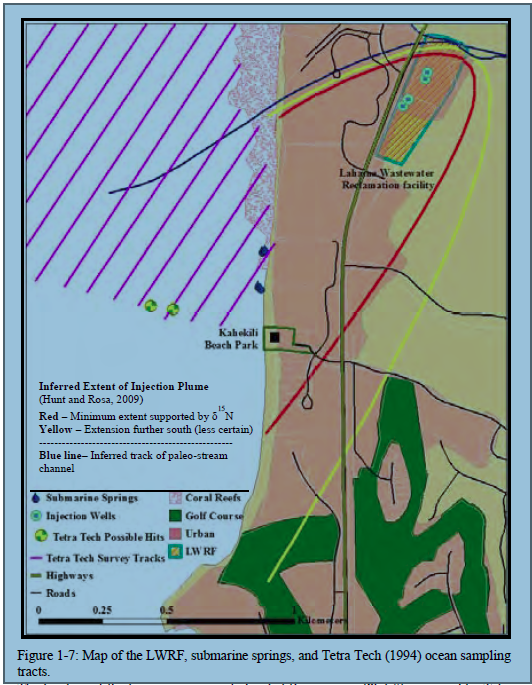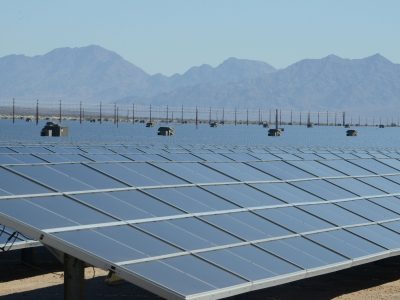Ninth Circuit rules Clean Water Act permit required for indirect discharge to ocean waters
Maui County can’t evade permitting requirements by sending wastewater to injection wells hydrologically connected to ocean waters

It was a great exam question (at least I thought so — you’ll have to ask my Environmental Law and Policy students if they agree): does the disposal of treated wastewater from a municipal wastewater treatment plant into the ground through injection wells located a short distance from the ocean require an NPDES permit under the Clean Water Act?
Like most great exam questions, this one was drawn from real life. That means it has a real (albeit not necessarily conclusive) answer, which the Ninth Circuit provided last week in Hawai’i Wildlife Fund v. County of Maui. I’m giving the panel a high grade.
Maui County’s Lahaina Wastewater Reclamation Facility treats some 4 million gallons of sewage daily. Four injection wells, located within a quarter mile of the shoreline, provide the primary means of disposing of the treated wastewater from the facility. The County has never had (or even sought) a Clean Water Act permit for its wells. When it constructed the facility in the 1970s, the County considered installing an ocean outfall, but decided that would be too harmful to the ocean waters. According to the Ninth Circuit, the County has known since the facility was constructed that effluent from the wells would reach the ocean. A 2013 tracer dye study by EPA, the state of Hawai’i, and others provided confirming data; dye injection into two of the wells emerged weeks later in nearby coastal waters. County concedes that effluent from the other wells also reaches the ocean. County’s effluent is enriched in nitrogen and phosphorous. According to environmental plaintiffs, the effluent causes serious ecological harm, promoting algal blooms and depleting oxygen.
In general, the Clean Water Act (CWA) requires a permit for any discharge of pollutants from a point source to the waters of the United States. Although there are plenty of arguments about the boundaries of federally jurisdictional waters, no one doubts that the oceans qualify. Nor is there any question that the wells themselves constitute point sources. The key question here was whether it mattered that the wells did not discharge directly to the ocean. Instead, they discharge to groundwater, which in turn is hydrologically connected to the ocean. The panel is careful not to say that groundwater is itself either subject to federal jurisdiction or a point source (see footnote 2 if you’re following along with the opinion). Instead, it takes this on as an indirect discharge case.
Indirect discharges like this one highlight the important distinction in the CWA between point source and non-point source pollution. For the former, the CWA mandates permits that must both require use of best available technology measures and prevent violation of water quality standards. For the latter, the CWA leaves virtually all decisions to state actors, many of whom have chosen to do little or nothing.
There has been a lot of confusion over the years about how to draw the boundaries between (federally regulated) point and (not federally regulated) non-point discharges. Indirect discharges are the source of much of that confusion, because by definition they originate from point sources but reach federal jurisdictional waters through some other pathway, typically a non-point source.
This decision helps us think about how to deal with that confusion, but doesn’t exactly clarify. The panel notes a number of past decisions, from several circuits, that have required NPDES permits for indirect discharges. It explains that the CWA does not regulate non-point discharges because of concerns about the ability to assign responsibility or to effect control. In the end, what drives the panel’s conclusion that a permit is required for the injection wells is its determination that the County knew its wells would dump substantial amounts of pollutants into ocean waters. The rule it announces is that a permit is required when pollutants discharged from a point source are “fairly traceable to a navigable water such that the discharge is the functional equivalent of a discharge into the navigable water” in a greater than de minimis amount. The decision expressly “leave[s] for another day the task of determining when, if ever, the connection between a point source and a navigable water is too tenuous to support liability under the CWA.”
What the court punts with that sentence, of course, is the core of the problem — how do you distinguish point from non-point source pollution in a way that does not go to either extreme? On the one hand, if permits are not required for at least some indirect discharges, polluters could evade regulation by deliberately structuring their process to avoid direct discharge (as the opinion here suggests Maui County sought to do). On the other hand, if the permit net is cast too widely, people who could not really avoid polluting waterways might end up caught in it.
While it declines to get specific, the panel does give some clues about where it thinks the limits of CWA jurisdiction lie. The court is at some pains to distinguish the Maui case from Ecological Rights Foundation v. PG&E, 713 F.3d 502 (9th Cir. 2013), where the Ninth Circuit rejected environmental plaintiffs’ claim that a utility needed a CWA permit because wood preservative leached from its power poles eventually reached federal jurisdictional waters. But it’s not at all clear what justifies that distinction. The panel is unwilling to say that it depends on intent (see footnote 1). It apparently views foreseeability as important, but I’m not sure that helps distinguish Ecological Rights Foundation. If you put a pole filled with wood preservative in the environment, it is surely not hard to foresee leaching or that pollutants that leach out of the poles will be carried to waterways.
Two cases currently pending in the Fourth Circuit raise the indirect discharge issue. The first is Upstate Forever v. Kinder Morgan, where the District Court dismissed a claim that a pipeline link which put oil into groundwater with a hydrological connection to navigable surface waters. The second is Sierra Club v. Virginia Electric Power, where the District Court ruled that the leaching of arsenic from coal ash piles into groundwater and through that groundwater to hydrologically connected surface waters required a permit. Upstate Forever, because the spill was accidental, strikes me as more like the utility pole case, but the Fourth Circuit may not have to address the permitting issue because there apparently was not yet any evidence that the pipeline’s oil had reached jurisdictional surface waters. But Sierra Club v. Virginia Electric Power should produce a ruling on the regulated status of indirect discharges. Stay tuned.
Reader Comments
4 Replies to “Ninth Circuit rules Clean Water Act permit required for indirect discharge to ocean waters”
Comments are closed.






The court may likewise assert that when one flushes their toilet then the wastewater eventually becomes a discharge of pollutants to waters of the United States from a point source and should therefore require a CWA permit from the EPA (unless this authority is delegated to the state in which case the state would issue the permit).
Nope. Discharges to the sewer system go through a wastewater treatment plant, which must have a CWA permit, so they do not require their own permit. Because some discharges to sewer systems can threaten the performance of wastewater treatment plants, or contain pollution that wastewater treatment plants are not designed to deal with, there is a special provision of the law that requires industrial dischargers to sewage systems to get permits for that purpose.
Holly,
Thanks for the clarification. We must protect our wastewater treatment plant from pollutants they are not designed to deal with. Clarifying climate mitigation is not so easy.
Yikes! Stormwater systems in CA are moving toward controls (best management practices) based on capture and infiltration of runoff in order to comply with their NPDES stormwater permits. The infiltration systems may be regulated under the State Water Code (and sometimes the SDWA) but do not require NPDES permits. Unless extracted for drinking water or irrigation purposes most of the infiltrated flows will eventually reach surface waters: rivers or the ocean. Potential mess ahead for an already confused regulatory program.
Thanks for the summary.